I am once again indebted to Dave Bull for sharing his fantastic collection of images of HMS Illustrious with Naval Air History. These photographs date from the immediate postwar period when the battered and war-weary carrier proved her usefulness yet again with a period as a trials and training carrier.
The latest set depicts training exercises involving two of the Fleet Air Arm’s most common types in the period between the end of the Second World War and the widespread adoption of jets, the Fairey Firefly and the Supermarine Seafire.
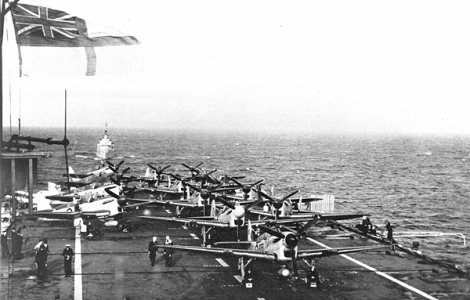
The Firefly was conceived in 1940 as a two-seat long-range fighter to replace the Fairey Fulmar (see A Problematic Naval Specification) and saw service in the last year of WW2 in its Mk.I guise. The Firefly provided the Fleet Air Arm with a versatile type for a range of tasks including all-weather fighter, anti-submarine aircraft and aircrew training.
The Fireflies are from 1830 Squadron, Abbotsinch, originally fighter/anti-submarine unit equipped with Fireflies and Seafires. The unit soon standardised on Fireflies and in August-September 1949, joined Illustrious for a period of embarkation and training, as seen here. The squadron carried out 205 accident-free deck-landings, for which it won the annual Boyd Trophy.
The second aircraft back is wearing a D tail code, indicating that it had been part of HMS Illustrious’ ship flight until recently. This aircraft does not appear to be carrying a radar pod, unlike most of the rest. The radar pod, carrying an American lightweight ASH radar set, was a simple modification that could turn the ‘straight fighter’ F.Mk.I into a reconnaissance and night-fighter type known as the FR.Mk.I. The former ship-flight aircraft also seems to be equipped with rocket rails.
Note also the range of spinner colours, and the two aircraft near the back in earlier dark upper camouflage schemes – at least the aircraft to the left-rear is in a wartime disruptive camouflage pattern. The ‘mixed bag’ nature of the aircraft suggests that they were drawn from other units that had switched to other types or disbanded.
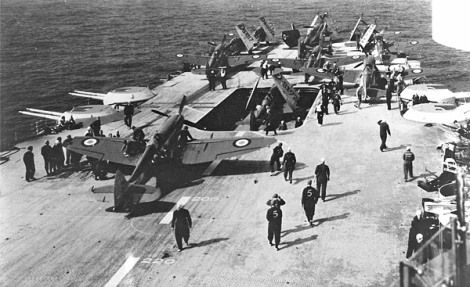
These photographs could be part of the same training detachment, with the Firefly Mk.Is arranged in Illustrious’ hangar along with a number of Seafire Mk.XVs and XVIIs. Illustrious, as the first of the armoured carriers, was often criticised for her lack of aircraft storage space. When initially commissioned, Illustrious carried around 33 aircraft, little more than a third of the number carried by contemporary US carriers. However, towards the end of the war, skilful hangar and deck management allowed up to 57 aircraft to be carried without problems (see Three Raids at the Beginning of the End).
The next image shows Seafire Mk.XVs and M.XVIIs being brought up on deck to launch (with a single Firefly Mk.I, forward and centre).
The Seafire was introduced as an emergency measure, largely due to the failure of pre-war naval aircraft policy (see The Spitfire’s Struggle To Go To Sea). It was never an ideal carrier fighter, being rather too fragile, and with poor visibility for landing. Its performance in the air was superb, though, and the Seafire was steadily developed along the lines of its land-based counterpart. The Mk.XV was the first Griffon-engined version of the Seafire, and was roughly the naval equivalent of the Spitfire Mk.XII, with a similar engine and flying services. The Mk.XVII was a developed version of the XV, with various improvements including a bubble canopy and long-stroke undercarriage. Neither saw service during the war, but together they became a standard type in the postwar RNVR fighter squadrons until largely replaced by the Hawker Sea Fury in the early 1950s.
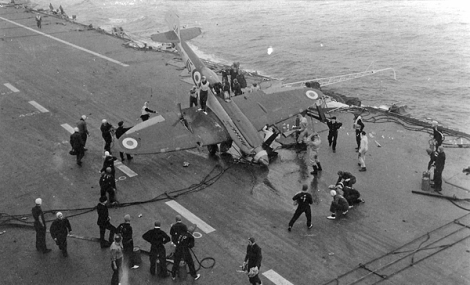
This is a Seafire Mk.XVII of 1831 Squadron, based at RNAS Stretton (hence the tail code ‘JA’) between 1947-1951. It was an RNVR fighter squadron equipped with Seafire XVs and XVIs using the codes 101-120. This aircraft appears to have missed all the wires and nosed over on striking the first crash barrier. There appears to be damage to the starboard cannon blister/ammunition hatch, possibly caused by the barrier when the aircraft struck.

Unfortunately, not all training exercises were as accident-free as 737’s period of embarkation on Illustrious. This image shows a Firefly F.Mk.I suffering a starboard main undercarriage collapse just as it picks up a wire. The Mk.I’s undercarriage seems to have been vulnerable to any side-load, and one of the first operational squadrons suffered three undercarriage collapses in a single launch exercise due to ground-loops.
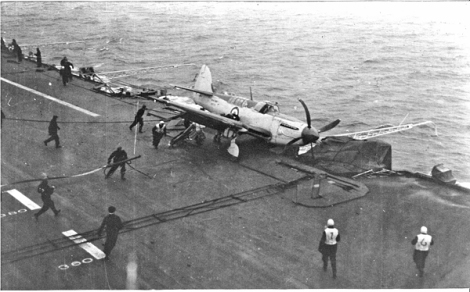
A different landing accident, this time involving a Firefly Mk.V. This could in fact be one of the first such aircraft undergoing deck trials as it carries no shore-base or individual aircraft codes. Evidently the aircraft has caught a wire but drifted to port and put a wheel over the side, stopping short of hitting the crash barrier (the triple-cable across the deck just ahead of the propeller). The crash barrier was introduced to British carriers during the war, based on American practice. Previously, each aircraft had to be struck down and lowered on the lift before the next aircraft could land. With the barrier, landed aircraft could be parked at the bow, speeding the exercise considerably.
The significantly-improved Firefly Mk.4 and Mk.5/6 did not reach squadrons during the war, but enhanced the FAA’s capabilities in the immediate postwar period, including during the Korean War. They benefitted from a more powerful Griffon engine than the Mk.I and improved aerodynamics, including wing-root radiators and an enlarged fin. The Mk.5 was a ‘universal’ type incorporating the improvements of the Mk.4 but with the ability to convert quickly to the anti-submarine Mk.6 or night fighter variant simply by exchanging equipment. Mk.4 aircraft were rapidly replaced by Mk.5s.
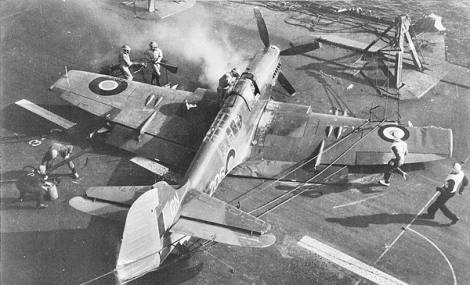
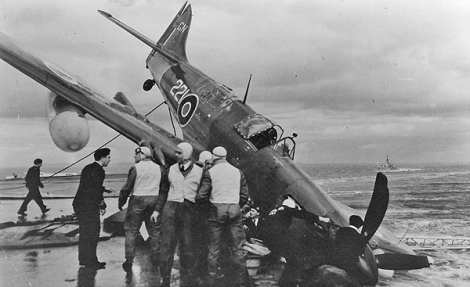
These two images show Fairey Firefly Mk.4s 206 and 221/GN, of 737 Naval Air Squadron, having come to grief during training exercises.
Number 737 Naval Air Squadron reformed at Eglinton (indicated by the ‘GN’ tail codes) in March 1949 as part of the 52nd Training Air Group. The squadron was equipped with Fireflies and Seafires to train aircrew in the use of air weapons and basic anti-submarine warfare. The Seafires left after a year, and from 1950 to 1955 the squadron used Fireflies exclusively, albeit in a range of marks.
The Fireflies shown here evidently earlier FR.Mk.4 aircraft given the disruptive camouflage scheme, later replaced with Extra Dark Sea Grey over Sky (originally with a low demarcation, then a high demarcation as seen in the images of 1830 Squadron – Mk.V aircraft were painted with the newer scheme at the factory).
Firefly 206 seems to have suffered an undercarriage collapse and hit the barrier while moving sideways.
Thanks once again to Dave Bull for sharing his remarkable collection of images from HMS Illustrious. For previous sets of images, see Fleet Air Arm Twins, HMS Illustrious and Prototypes and Trials, HMS Illustrious
